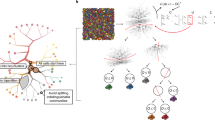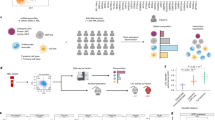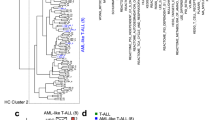Abstract
Acute lymphoblastic leukemias carrying a chromosomal translocation involving the mixed-lineage leukemia gene (MLL, ALL1, HRX) have a particularly poor prognosis. Here we show that they have a characteristic, highly distinct gene expression profile that is consistent with an early hematopoietic progenitor expressing select multilineage markers and individual HOX genes. Clustering algorithms reveal that lymphoblastic leukemias with MLL translocations can clearly be separated from conventional acute lymphoblastic and acute myelogenous leukemias. We propose that they constitute a distinct disease, denoted here as MLL, and show that the differences in gene expression are robust enough to classify leukemias correctly as MLL, acute lymphoblastic leukemia or acute myelogenous leukemia. Establishing that MLL is a unique entity is critical, as it mandates the examination of selectively expressed genes for urgently needed molecular _targets.
This is a preview of subscription content, access via your institution
Access options
Subscribe to this journal
Receive 12 print issues and online access
We are sorry, but there is no personal subscription option available for your country.
Buy this article
- Purchase on SpringerLink
- Instant access to full article PDF
Prices may be subject to local taxes which are calculated during checkout






Similar content being viewed by others
References
Rowley, J.D. The critical role of chromosome translocations in human leukemias. Annu. Rev. Genet. 32, 495–519 (1998).
Gu, Y. et al. The t(4;11) chromosome translocation of human acute leukemias fuses the ALL-1 gene, related to Drosophila trithorax, to the AF-4 gene. Cell 71, 701–708 (1992).
Tkachuk, D.C., Kohler, S. & Cleary, M.L. Involvement of a homolog of Drosophila trithorax by 11q23 chromosomal translocations in acute leukemias. Cell 71, 691–700 (1992).
Domer, P.H. et al. Acute mixed-lineage leukemia t(4;11)(q21;q23) generates an MLL–AF4 fusion product. Proc. Natl Acad. Sci. USA 90, 7884–7888 (1993).
Pui, C.H. et al. Clinical characteristics and treatment outcome of childhood acute lymphoblastic leukemia with the t(4;11)(q21;q23): a collaborative study of 40 cases. Blood 77, 440–447 (1991).
Behm, F.G., Smith, F.O., Raimondi, S.C., Pui, C.H. & Bernstein, I.D. Human homologue of the rat chondroitin sulfate proteoglycan, NG2, detected by monoclonal antibody 7.1, identifies childhood acute lymphoblastic leukemias with t(4;11)(q21;q23) or t(11;19)(q23;p13) and MLL gene rearrangements. Blood 87, 1134–1139 (1996).
Dimartino, J.F. & Cleary, M.L. Mll rearrangements in haematological malignancies: lessons from clinical and biological studies. Br. J. Haematol. 106, 614–626 (1999).
Yu, B.D., Hess, J.L., Horning, S.E., Brown, G.A. & Korsmeyer, S.J. Altered Hox expression and segmental identity in Mll-mutant mice. Nature 378, 505–508 (1995).
Hess, J.L., Yu, B.D., Li, B., Hanson, R. & Korsmeyer, S.J. Defects in yolk sac hematopoiesis in Mll-null embryos. Blood 90, 1799–1806 (1997).
Buske, C. & Humphries, R.K. Homeobox genes in leukemogenesis. Int. J. Hematol. 71, 301–308 (2000).
Nakamura, T. et al. Fusion of the nucleoporin gene NUP98 to HOXA9 by the chromosome translocation t(7;11)(p15;p15) in human myeloid leukaemia. Nature Genet. 12, 154–158 (1996).
Borrow, J. et al. The t(7;11)(p15;p15) translocation in acute myeloid leukaemia fuses the genes for nucleoporin NUP98 and class I homeoprotein HOXA9. Nature Genet. 12, 159–167 (1996).
Golub, T.R. et al. Molecular classification of cancer: class discovery and class prediction by gene expression monitoring. Science 286, 531–537 (1999).
Hardy, R.R. & Hayakawa, K. B cell development pathways. Annu. Rev. Immunol. 19, 595–621 (2001).
LeBien, T.W. Fates of human B-cell precursors. Blood 96, 9–23 (2000).
Murre, C. Role of helix–loop–helix proteins in lymphocyte development. Cold Spring Harb. Symp. Quant. Biol. 64, 39–44 (1999).
Fruman, D.A. et al. Impaired B cell development and proliferation in absence of phosphoinositide-3-kinase p85α. Science 283, 393–397 (1999).
Schubart, K. et al. B cell development and immunoglobulin gene transcription in the absence of Oct-2 and OBF-1. Nature Immunol. 2, 69–74 (2001).
Frank, K.M. et al. Late embryonic lethality and impaired V(D)J recombination in mice lacking DNA ligase IV. Nature 396, 173–177 (1998).
Yin, A.H. et al. AC133, a novel marker for human hematopoietic stem and progenitor cells. Blood 90, 5002–5012 (1997).
Rosnet, O. et al. Human FLT3/FLK2 gene: cDNA cloning and expression in hematopoietic cells. Blood 82, 1110–1119 (1993).
Dong, W.F., Billia, F., Atkins, H.L., Iscove, N.N. & Minden, M.D. Expression of rhombotin 2 in normal and leukaemic haemopoietic cells. Br. J. Haematol. 93, 280–286 (1996).
Yang, R. et al. Cyclin A1 expression in leukemia and normal hematopoietic cells. Blood 93, 2067–2074 (1999).
Remold-O'Donnell, E., Chin, J. & Alberts, M. Sequence and molecular characterization of human monocyte/neutrophil elastase inhibitor. Proc. Natl Acad. Sci. USA 89, 5635–5639 (1992).
Rosenberg, H.F., Ackerman, S.J. & Tenen, D.G. Human eosinophil cationic protein. Molecular cloning of a cytotoxin and helminthotoxin with ribonuclease activity. J. Exp. Med. 170, 163–176 (1989).
Ho, E.L. et al. Murine Nkg2d and Cd94 are clustered within the natural killer complex and are expressed independently in natural killer cells. Proc. Natl Acad. Sci. USA 95, 6320–6325 (1998).
Kondo, M., Weissman, I.L. & Akashi, K. Identification of clonogenic common lymphoid progenitors in mouse bone marrow. Cell 91, 661–672 (1997).
Nakamura, T., Largaespada, D.A., Shaughnessy, J.D. Jr, Jenkins, N.A. & Copeland, N.G. Cooperative activation of Hoxa and Pbx1-related genes in murine myeloid leukaemias. Nature Genet. 12, 149–153 (1996).
Rozovskaia, T. et al. Upregulation of Meis1 and HoxA9 in acute lymphocytic leukemias with the t(4:11) abnormality. Oncogene 20, 874–878 (2001).
Venables, W.N. & Ripley, B.D. Modern Applied Statistics with S-Plus (Springer, New York, 1994).
Dasarathy, V.B. (ed.) Nearest Neighbor (NN) Norms: NN Pattern Classification Techniques (IEEE Computer Society Press, Los Alamitos, 1991).
Hu, M. et al. Multilineage gene expression precedes commitment in the hemopoietic system. Genes Dev. 11, 774–785 (1997).
Montecino-Rodriguez, E., Leathers, H. & Dorshkind, K. Bipotential B-macrophage progenitors are present in adult bone marrow. Nature Immunol. 2, 83–88 (2001).
Cumano, A., Paige, C.J., Iscove, N.N. & Brady, G. Bipotential precursors of B cells and macrophages in murine fetal liver. Nature 356, 612–615 (1992).
Nutt, S.L., Heavey, B., Rolink, A.G. & Busslinger, M. Commitment to the B-lymphoid lineage depends on the transcription factor Pax5. Nature 401, 556–562 (1999).
Borrello, M.A. & Phipps, R.P. The B/macrophage cell: an elusive link between CD5+ B lymphocytes and macrophages. Immunol. Today 17, 471–475 (1996).
Hanson, R.D. et al. Mammalian Trithorax and polycomb-group homologues are antagonistic regulators of homeotic development. Proc. Natl Acad. Sci. USA 96, 14372–14377 (1999).
Ludwig, W.D. et al. Immunophenotypic and genotypic features, clinical characteristics, and treatment outcome of adult pro-B acute lymphoblastic leukemia: results of the German multicenter trials GMALL 03/87 and 04/89. Blood 92, 1898–1909 (1998).
Silverman, L.B. et al. Intensified therapy for infants with acute lymphoblastic leukemia: results from the Dana-Farber Cancer Institute Consortium. Cancer 80, 2285–2295 (1997).
Pieters, R. et al. Relation between age, immunophenotype and in vitro drug resistance in 395 children with acute lymphoblastic leukemia—implications for treatment of infants. Leukemia 12, 1344–1348 (1998).
Tallman, M.S. et al. All-trans-retinoic acid in acute promyelocytic leukemia. N. Engl. J. Med. 337, 1021–1028 (1997).
Druker, B.J. et al. Efficacy and safety of a specific inhibitor of the BCR–ABL tyrosine kinase in chronic myeloid leukemia. N. Engl. J. Med. 344, 1031–1037 (2001).
Nakao, M. et al. Internal tandem duplication of the flt3 gene found in acute myeloid leukemia. Leukemia 10, 1911–1918 (1996).
Zhao, M. et al. In vivo treatment of mutant FLT3-transformed murine leukemia with a tyrosine kinase inhibitor. Leukemia 14, 374–378 (2000).
Tse, K.F., Mukherjee, G. & Small, D. Constitutive activation of FLT3 stimulates multiple intracellular signal transducers and results in transformation. Leukemia 14, 1766–1776 (2000).
Loh, M.L. et al. Incidence of TEL/AML1 fusion in children with relapsed acute lymphoblastic leukemia. Blood 92, 4792–4797 (1998).
Cuthbert, G., Thompson, K., Breese, G., McCullough, S. & Bown, N. Sensitivity of FISH in detection of MLL translocations. Genes Chromosom. Cancer 29, 180–185 (2000).
Acknowledgements
We thank V. Dalton, S. Waters, A. Cardoso and N. Haining for help with accumulating samples and obtaining clinical data; J. Korsmeyer and D. Neuberg for help with statistical analysis; J. Fletcher for help with interpretation of cytogenetic data; E. Smith for assistance with figures and editing; C. Ladd, M. Angelo and other members of the Whitehead/MIT Center for Genome Research Program in Cancer Genomics for technical help and developing data analysis tools and P. Ernst and J. Hsieh for discussions. This work was supported in part by an NIH grant, an American Society of Hematology Fellow Scholar Award (S.A.A.), an American Society of Hematology Junior Faculty Scholar Award (T.R.G.), the Belfer Cancer Genomics Center and Bristol-Myers Squibb, Millennium Pharmaceuticals, and Affymetrix (T.R.G.).
Author information
Authors and Affiliations
Corresponding authors
Supplementary information
Rights and permissions
About this article
Cite this article
Armstrong, S., Staunton, J., Silverman, L. et al. MLL translocations specify a distinct gene expression profile that distinguishes a unique leukemia. Nat Genet 30, 41–47 (2002). https://doi.org/10.1038/ng765
Received:
Accepted:
Published:
Issue Date:
DOI: https://doi.org/10.1038/ng765



